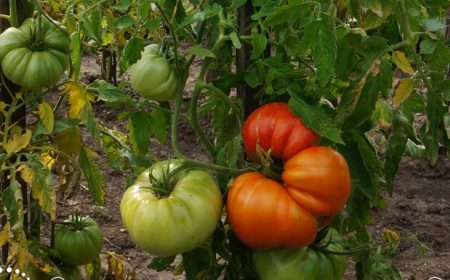
Grandmother’s tomato joy is one of the popular varieties that many growers like, as it has established itself with many advantages - excellent taste, yield, large fruits.
However, with improper care, certain disadvantages may also appear, therefore, in order to prevent mistakes during cultivation, we will consider this variety in more detail.
Content
The main characteristics of the variety
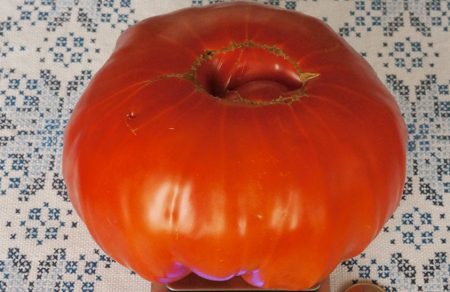
Tomato Babushkina joy refers to mid-season, indeterminate varieties. The plant is quite tall, with its growth, the bush can reach 1.8 meters, therefore, it needs timely installation of support and pinching. The most optimal is the formation of plants in 1 or 2 stems.
The variety is famous for productivity. The fruits are round, in the ripeness stage of red color. The weight of one tomato varies and with proper agricultural technology can reach 250-500 grams (and in some cases a kilogram). If you want really large fruits, then form a plant in 1 stalk (but there will be fewer of them than when forming in 2 stems). The tomato is tasty, fleshy juicy.
The main purpose: to a greater extent, the variety is suitable for fresh consumption, the preparation of juices and sauces. Due to the relatively large size, the tomato as a whole is not so often preserved.
The variety is suitable for cultivation both in the open ground and in the greenhouse. Tomatoes are grown on open ground in the southern regions, and in the middle lane - in the greenhouse lane.
Advantages and disadvantages of the variety
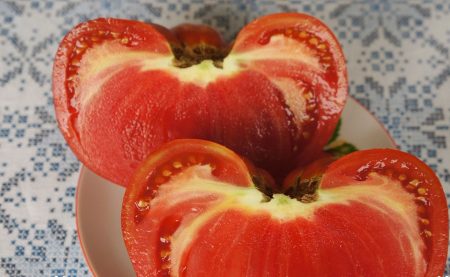
Grandma’s tomato joy has a lot of advantages that are very much appreciated by both novice vegetable growers and more experienced ones:
- Large fruits, which with proper care can reach 1 kg (an average of 250-500 grams).
- High productivity - up to 5 kg from 1 bush.
- The variety has extended fruiting.
- Resistance to a number of diseases (late blight, etc.).
- Unpretentious in leaving.
The variety has no special drawbacks. But at the same time, like any other plant, with improper care, it can become sick, which can adversely affect its development and fruiting.
Features of cultivation and care
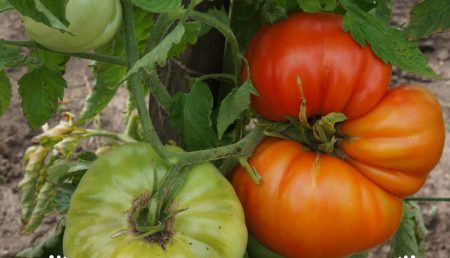
If you want to get a really good crop, you should pay attention to growing and caring for the plant. This variety is grown in seedlings, the seeds are sown in late March, if you want to grow a tomato in greenhouse conditions, then you can already squeeze the seeds in late February. Remember that transplanting into open ground or a greenhouse normally occurs after 60-70 days.
Preselect good seeds:
Firstly, they should not be old, therefore, more than 2 years should not pass from the moment of release.
Secondly, select the seeds for this:
- Dissolve half a spoonful of salt in a glass of water.
- Add seeds and leave for half an hour.
- Remove pop-up seeds, and the rest can be planted.
Then it’s better to germinate them. To do this, spread the seeds on a wet cloth and leave them for several days (usually 5), as the seeds germinate, they can be planted. Those that do not germinate, it is better not to plant, many vegetable growers believe that such plants will be weak and may hurt.
It is preferable to buy the soil for planting seedlings in a specialized store, because it will have a balanced composition of trace elements that are needed for plant nutrition. Pre-water the soil thoroughly, and then plant the seeds. In this case, it is not necessary to greatly part, but place the seeds at a distance of 1 cm from each other. Then cover the container with foil and leave until the first shoots in a warm place.
Water the sprouts as needed. As you will notice that 1-2 full leaflets have appeared, you can proceed to the transplant.
The transplantation to the main place is performed when the plants get stronger and the possibility of frost (the end of May) is excluded. Do not plant bushes too often - the optimal ratio is 3 plants per 1 sq. Km. m
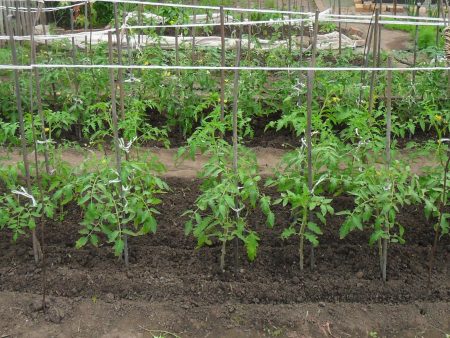
Further care for the variety is as follows:
- Timely and moderate watering. The best time for watering is evening.
- Do not forget about loosening the soil. The soil must be loosened the day after watering to prevent the formation of a hard crust, which often causes oxygen starvation of the root system.
- Weeding - remember weed removal is one of the methods of prevention against a number of diseases and root rot.
Do not forget about fertilizers. Tomatoes need to be fed throughout the season. It is optimal to use complex formulations for this. At least you need to fertilize the plant three times in the summer:
- First, 14 days after planting in open ground.
- During flowering and fruit set.
- During ripening.
Also, one should not forget about fertilizing seedlings, it is carried out in 2 stages:
- 14 days after germination.
- 2 weeks before landing at the main landing site.
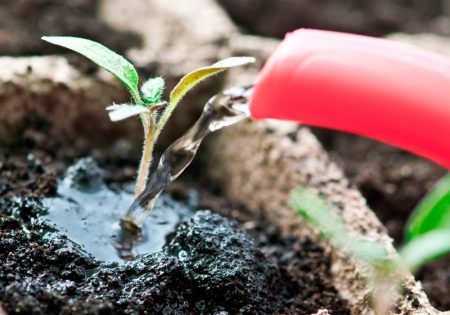
As noted earlier, it is better to use specialized complex fertilizers for top dressing, such as:
- Nitrofoska.
- Potassium sulfate.
- Superphosphate.
Organic fertilizers are also often used, but they (like mineral fertilizers) should be very careful, since excessive fertilizer can adversely affect the development of the plant.
Disease and pest resistance
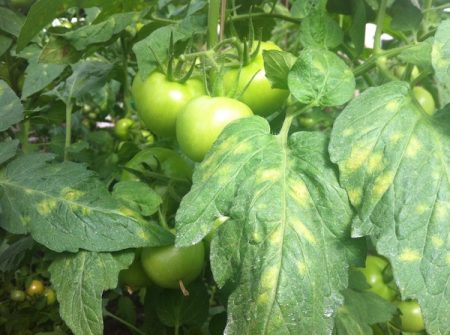
As noted above, the variety is not afraid of a number of diseases, including such a serious disease as late blight, but with all the rainbow of the picture, disease prevention should be remembered. When growing in a greenhouse, it must be periodically ventilated, use on open ground, and in greenhouse conditions, special remedies for diseases that can be bought at a gardening store.
Also remember about pest protection, tomatoes often suffer from:
- Whiteflies;
- caterpillars
- aphids;
- spider mites, etc.
Alternative methods of prevention do not always work, so it is optimal to purchase specialized products in a gardening store.
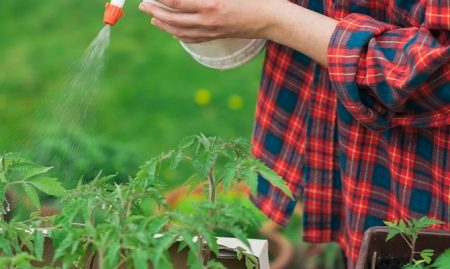
Reviews of those who planted
Sergey
An excellent variety that I will now constantly grow in the country. Specially planted two beds of this variety, formed on one 1 stalk, on the other 2 stems. On the first one there are very large fruits, which really surprised in size, and on the second one they are also large and in larger quantities. In general, everything is fine.
Pavel
I am a freshman, a vegetable grower, therefore, when growing in greenhouse conditions, I forgot to ventilate periodically, so the bushes became rotten. Some could not be cured, but those that were saved were pleased with their harvest - so next year I will come up wisely to cultivate and get an even larger crop.
Olga
A wonderful variety that I immediately liked. It is easy to grow it, as fertilizers I used to use nitrofoska, which is easy to bait. Previously, many seeds were soaked in a growth stimulator, but these sprouted so quickly.
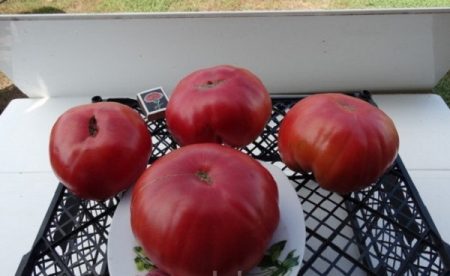
Grandma’s tomato joy is an organic combination of a lot of advantages with virtually no flaws, thanks to this he will be able to bring a rich and tasty harvest,which will please you and loved ones!




 Low-growing tomatoes, without pinching: 5 of the most delicious varieties
Low-growing tomatoes, without pinching: 5 of the most delicious varieties Why tomato seedlings grow poorly
Why tomato seedlings grow poorly We grow a tomato in a shell
We grow a tomato in a shell Growing tomatoes without watering according to the method of Kazarin
Growing tomatoes without watering according to the method of Kazarin